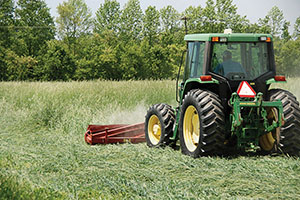Beyond Agriculture: The Whole Farm Approach to Pests
 |
|
Roller crimper in action. Photo by Steven Mirsky, U.S. Department of Agriculture. |
What makes you change your way of life? Sometimes an internal calling brings about new behavior. Government regulations can force change. Change can be rapid or slow in forming, requiring years of stimuli, until one day something clicks, or just makes more sense. Often, if you make a habit of personal reflection, new opportunities appear when you look back at what just happened.
Ecology of Change
Christopher Philips of the University of Minnesota and co-authors describe the “IPM continuum,” a concept that ranges from none, to low-level, to high-level IPM. For the moment, set aside the practices. What is the thinking?
On a 175-acre vegetable farm in Pennsylvania, a farmer plants winter cover crops, uses a roller crimper to knock them down, then transplants her tomatoes into a thick mulch. Soon, she begins to see a delay in early blight, and less pest pressure generally.
In an apartment high-rise, the manager takes ownership of the building’s entire pest control operations. He oversees frequent monitoring, the sealing of openings and cracks, and the keeping of disposal areas free from food waste.
The farmer and the building manager have in common an approach that views the theater—whether farm or building—as an ecosystem. The theater could be a farm field, a garden, someone’s backyard, or a 64,000 square-mile watershed.
Gaining Momentum
A decade ago, the Sustainable Agriculture Research and Education (SARE) program documented growers and researchers taking a whole farm approach to managing pests in crop fields. Fast forward to today and you’ll see the “whole farm” idea used for any number of settings, such as schools, ranches, single-family homes, factories, warehouses, and offices.
For the farmer, perhaps she sees the benefits of a resilient system much more resistant to pests. For the building manager, evidence of long-term savings and lower risks to human health may bring the tipping point.
Ecological pest management employs a whole farm approach where no rock in the field is left unturned, and no brick in the building is overlooked.
A Framework, Not Tools
Early advocates of IPM believed that a single approach is a poor substitute for a system-wide strategy to control pests. IPM is a process that mimics nature as much as possible, adapting with the landscape as the farmer grows food and fiber, and as the building manager keeps pests at bay by preventing them from entering the structure. IPM proponents—on farms, in cities, in parks, and wherever else pests may occur— have a whole farm mentality for limiting pests and their damage.
Reference
Philips, Christopher R; Kuhar, Thomas P; Hoffmann, Michael P; Zalom, Frank G; Hallberg, Rosemary; Herbert, D Ames; Gonzales, Christopher; and Elliott, Steve (October 2014) Integrated Pest Management. In: eLS. John Wiley & Sons, Ltd: Chichester. DOI: 10.1002/9780470015902.a0003248.pub2
— by CHRIS GONZALES and STEVE YOUNG
The Northeastern IPM Center promotes integrated pest management for reducing risks to human health and the environment. If republishing our news, please acknowledge the source (“From Northeast IPM Insights”) along with a link to our website.
